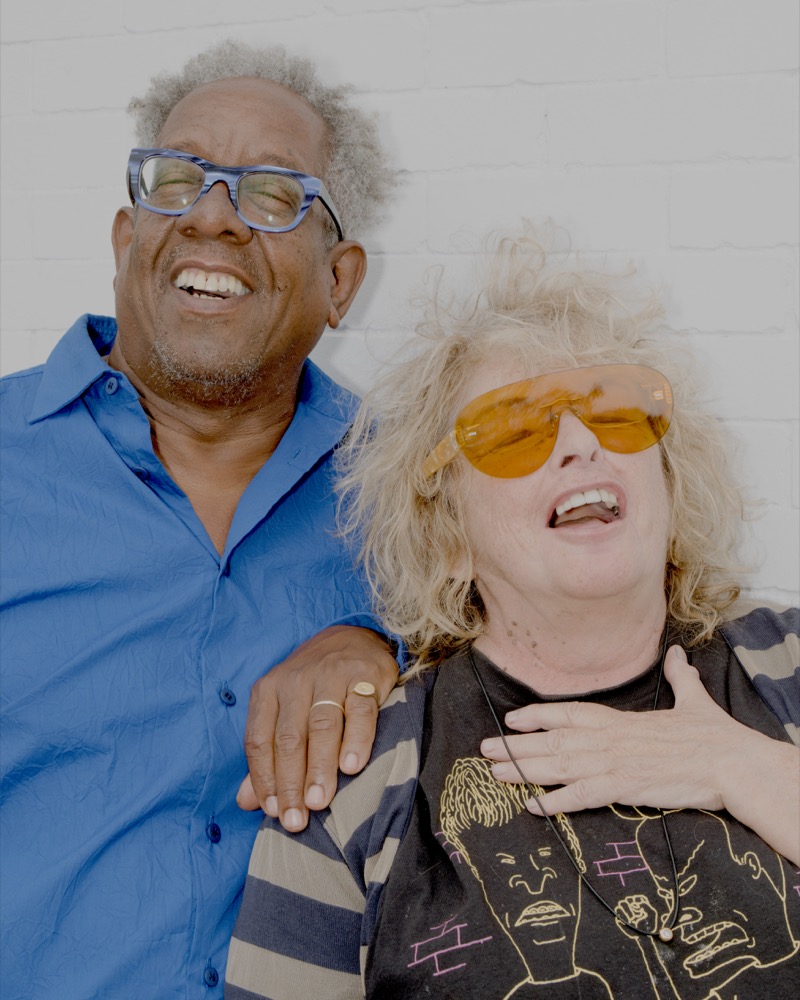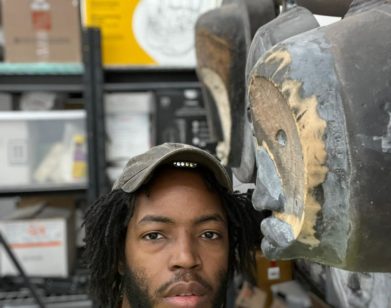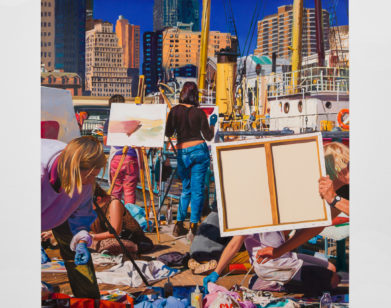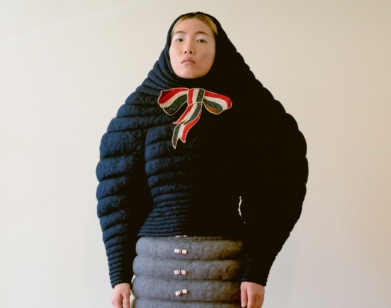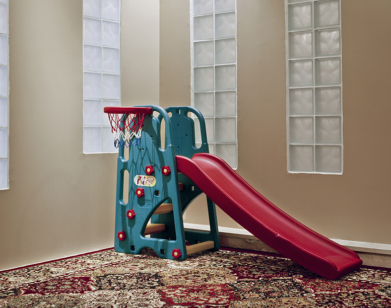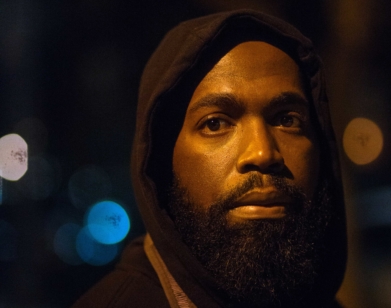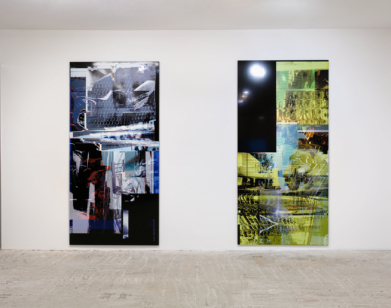How two offbeat artists made New York their own
Stanley Whitney likes to sing at the top of his lungs—an unsurprising fact, perhaps, for those familiar with his work. Music (in particular jazz) seems to not only inspire, but also emanate from Whitney’s paintings: shapes swim, colors swarm, and lines tremble in improvised harmony. Known for freehand geometry, irregular grids, and fierce hues that flitter on canvas, the 70-year-old abstractionist spent over four decades delving into color as the subject of his work.
Born in Philadelphia, Whitney was the only member of his family in the arts (“No one knows what happened,” he explains. “I fell on my head—I don’t know.”). Whitney drew on walls, in elementary school, for local newspapers; he attended a small art school in his neighborhood at 10, earned a B.F.A from Kansas City Art Institute, an M.F.A. from Yale, and moved to New York in the late 1960’s.
Around that time, Brooklyn-native painter and friend Joyce Pensato was studying at the New York Studio School (which Whitney also briefly attended). “You have the circles and squares,” she said to Whitney. “And I draw the ducks and mice.”
Pensato’s dripping enamel paintings that feature familiar yet eerie faces—Mickey Mouse, Batman, Donald Duck—may seem antithetical to Whitney’s solid blocks of color. The pair’s careers, however, have shared somewhat similar trajectories. Now, Whitney’s paintings have been assembled for Stanley Whitney: Drawings, at New York’s Lisson Gallery. Pensato, in her signature outsized wraparounds, is set to join a group exhibition at ICA Miami. Both have come a long way from sleeping on hardwood floors…
STANLEY WHITNEY: Should we talk about when we came to New York? Let’s talk about that.
JOYCE PENSATO: I’ve been here. Never got out, thank you. When did you get here?
WHITNEY: I came to New York really in ‘68. I have a new studio in Bushwick now and you grew up there.
PENSATO: I grew up in Bushwick and I will never go back. [laughs]
WHITNEY: So I got out of high school and wanted to come to New York to study at the School of Visual Arts in a three-year program.
PENSATO: Did you always feel like this was what you wanted to do?
WHITNEY: Yes, I was always an artist; I didn’t know what kind of art but I knew I was an artist. I spent high school looking out the window … I was a terrible student and just barely got through [laughs]. But then when I got to art school, that was a big thing. That was a big change for me. When did you first start showing?
PENSATO: Officially, I think the early ‘90s. I was in group shows at Luhring Augustine and 303 Gallery and my head was very big. Then a French dealer invited me to do my first show in Paris. I came back and asked Luhring Augustine, “When am I getting the ring?” [laughs] I can’t believe I actually said that with a big smile on my face. And they couldn’t make a decision to take the art or not.
WHITNEY: Bet they regret it now.
PENSATO: The ship came back in the last 10 years so … knock on wood.
WHITNEY: The same thing happened with me. I ended up going to Yale and then I started teaching right away. People were showing but I wasn’t—it was a depressing time … I couldn’t get my foot in the door.
PENSATO: That was the hardest thing. People would say, “Where are you showing?” “I’m showing in my apartment!” [laughs] Later when I showed in Europe, in Paris, I could be free and develop my paintings. Then, you come to New York and well … [pauses] But I think both our ships came in. This is it.
WHITNEY: That’s true. Now we’re doing well.
PENSATO: And we’re doing what we love and now people are loving it too. I mean, we’ve been doing the same fucking thing for I don’t know how long. You have the circles and squares and I draw the ducks and mice.
WHITNEY: We’ve been doing it forever. It’s funny because even in the drawings show, there are drawings in there that I said, “These are rejects—I’m not showing these.” But now they look good!
PENSATO: It’s alive and it’s fantastic! Also when I think of your work, I look at it and I go, “Oh my God, I’ve been doing Mickey for I don’t know how long.”
WHITNEY: You started drawing those at the [Studio] School, right?
PENSATO: I started with pop culture in the ‘70s.
WHITNEY: I read that interview where you said that you didn’t want to draw this cast thing—
PENSATO: Still life. Horrible thing.
WHITNEY: And she said, “Well, draw whatever you want.” And you go across the street, bought the Mickey Mouse thing, and you drew that.
PENSATO: It was Batman and the other guys and I set it up as a still life. [laughs]
WHITNEY: Why did you go to the abstract stuff? Were you drawing one thing and painting something else?
PENSATO: In the ‘80s I was so torn, I was like two different people. I loved to do drawings of the dolls or whatever and I was trying to get a hold of how to make a painting. And when I started to paint, I lost the graphics and they became abstract.
WHITNEY: It’s funny about all of that, being so ambitious when you’re young and you do so many things. With me I was always doing too many things: I would have a studio and I would have things all over the walls—art postcards that I write would go floor to ceiling. I just had stuff everywhere. I had work everywhere.
For a long time I didn’t know how to market my work but I didn’t really know how to think about what I wanted from the art world. I wanted to be successful, but I didn’t know what that meant. I’d just work and work and work. I think in the long run, it’s a good thing.
PENSATO: Well, you have to love what you do and not do what you don’t.
WHITNEY: And I love what I’m doing. I just couldn’t figure out, really, what that meant in terms of outside the studio. People couldn’t figure out for a long time what I was. Like, “What kind of animal are you?” I think that was a big thing. For me, race is a big thing.
PENSATO: You always were about color, too. To me, you always had color.
WHITNEY: I was always about color. People used to come see me and ask if I was from the islands. There was always a lot of color.
PENSATO: To me when I see your work and feel your work, it’s music.
WHITNEY: The music was always there because in my house, growing up in Philadelphia—it’s a big music town. You go to sleep with the radio on; you wake up with the radio on. Music was always playing—music, music, music. In fact, when I was in junior high, in my neighborhood, the black neighborhood, the most important thing you did when you came home from school was you learned to dance.
I got involved with this guy in my neighborhood [who] played piano-jazz. He had these records—Thelonious Monk, and Ornette Coleman. When I heard that stuff, I was home. This is it. That’s it right there for me. Music was always there. My mother once told my wife, Marina, that I was always singing.
PENSATO: Do you still sing?
WHITNEY: Yeah, I sing when I’m on a bicycle. I sing at the top of my lungs—I think no one can hear me. [laughs] I always sing.
PENSATO: [laughs] You need to make a recording of that.
WHITNEY: Never! [laughs] I sing a lot.
PENSATO: Wow, who knew!
WHITNEY: Sometimes I don’t even know it. [laughs] Music for me is what set my work apart from the other people with the color in the room. I think as an artist or painter, there are so many paintings that you have to bring something else to it.
PENSATO: Well, you bring your heart—yourself.
WHITNEY: What you do in terms of your drawings—you bring so many different things to it. You kind of extend that idea.
PENSATO: It’s an emotion. I don’t think of myself as a cartoonist, I bring my sense of humor—
WHITNEY: You add a whole new link to the chain, you know what I mean? You always have to add something to it. For me it’s the color, the music. It’s a rhythm. It’s really like an Afro-American rhythm to it. That’s the thing.
PENSATO: I’m in a position where I could do whatever I like. And so I’m bringing my whole self, which is my sense of humor.
WHITNEY: I think it’s great. I think now we can work. As an artist you want to work to your potential. And I think now we can. Whatever you wanna do, you can do.
PENSATO: Whatever dream you have, you can make that dream happen. [laughs] Did you always feel like you were going to make it? Like something was there for you?
WHITNEY: No, I didn’t really. When you’re young, people think it’s a race. People were showing right away and I wasn’t. I really got devastated—sick, even! I overate. I just couldn’t believe it because I was a big success in art school, and then after art school, nothing happened.
PENSATO: You had to start from the bottom!
WHITNEY: Right from the bottom! I realized you don’t compare your career to anybody else because if you do, it’s gonna eat you alive.
PENSATO: You get trapped in that.
WHITNEY: Right, and the worst thing about it is that you become bitter. And I thought, “Well, Stanley, you know, you’re making a mediocre living, you’re not doing bad, you’re doing okay.” I’m just going to do my work and have a really good life no matter what.
PENSATO: And you did.
WHITNEY: And I did. And now things worked out, but if they hadn’t I’d probably be doing the same thing anyway. Thinking about being older, the money and the comfort is nice. [laughs] When you’re young you could sleep on a hardwood floor—you could sleep on anything! I could sleep on this floor! Now, I need a comfortable bed.
PENSATO: Once you had a taste of the good stuff, that’s it. You can’t go back.
WHITNEY: That’s how I see it.
PENSATO: Are you having the best time now?
WHITNEY: Of course.
PENSATO: Me too.
WHITNEY: Now I’m in my beautiful studio all the time.
PENSATO: You have a great gallery, you have a beautiful son. Marina is great. Look at you! Look at me! I’m having the best time.
WHITNEY: Yeah, it’s really great. Knock on wood.
PENSATO: Knock on wood. [knocks]
STANLEY WHITNEY: DRAWINGS IS AT LISSON GALLERY UNTIL OCTOBER 21, 2017. JOYCE PENSATO WILL SHOW AS PART OF GROUP EXHIBITION THE EVERYWHERE STUDIO AT ICA MIAMI THIS DECEMBER.

